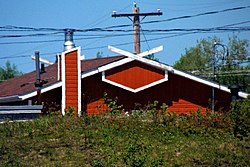
The Gouin Reservoir is a man-made lake, fully within the boundaries of the City of La Tuque, Quebec, Canada. It is not one contiguous body of water, but the collective name for a series of connected lakes separated by innumerable bays, peninsulas, and islands with highly irregular shapes. It has therefore a relative long shoreline of over 5,600 km (3,500 mi) compared to its surface area of 1,570 km2 (610 sq mi). It is the source of the Saint-Maurice River.

The Toussaint River is a tributary of the north shore of the Gouin Reservoir, flowing in Quebec, in Canada in the administrative region of:

The Kakospictikweak River is a tributary of the North Shore of Gouin Reservoir, sinking in Quebec, Canada in the administrative region of Mauricie of:

The Jean-Pierre River is a tributary of the Jean-Pierre Bay, on the south shore of the Gouin Reservoir, flowing into the territory of the town of La Tuque, into the administrative region of Mauricie, in Quebec, in Canada.

The Leblanc River is a tributary of the De La Galette River, flowing on the south shore of the Gouin Reservoir, in the territory of the town of La Tuque, in the Mauricie administrative region, in Quebec, in Canada.

The Kikendatch Bay is a freshwater body that leads to the Gouin Reservoir, in the territory of La Tuque, in Haute-Mauricie, in the administrative region of Mauricie, in the province of Quebec, in Canada.

The Nemio River is a tributary of the south shore of the Gouin Reservoir, flowing in the town of La Tuque, in the administrative region of Mauricie, in Quebec, in Canada.

The Tessier Lake is a freshwater body located on the south side of the southwestern part of the Gouin Reservoir, in the territory of the town of La Tuque, in the region of Mauricie, in the province of Quebec, in Canada.
The Faucher River is a tributary of Tessier Lake located on the southwestern side of the Gouin Reservoir. This river runs in the town of La Tuque, in the administrative region of Mauricie, in Quebec, in Canada.
Bignell Creek is a tributary of the Adolphe-Poisson Bay located on the southwestern side of the Gouin Reservoir. This stream runs entirely in forest zone in the town of La Tuque, in the administrative region of Mauricie, in Quebec, in Canada.

Plamondon Bay is a body of freshwater located in the western part of Gouin Reservoir, in the territory of the town of La Tuque, in the administrative region of the Mauricie, in the province of Quebec, in Canada.

The Male Lake is a freshwater body located in the western part of the Gouin Reservoir, in the territory of the town of La Tuque, in the administrative region of the Mauricie, in the province of Quebec, in Canada.

The Bourgeois Lake is a freshwater body located in the north central part of the Gouin Reservoir, in the territory of the town of La Tuque, in the administrative region of the Mauricie, in the province of Quebec, in Canada.

Thibodeau Bay is a freshwater body located in the north central part of the Gouin Reservoir, in the territory of the town of La Tuque, in the administrative region of the Mauricie, in the province of Quebec, in Canada.
The Piponisiw River is a tributary of Simard Lake located in the western part of the Gouin Reservoir, flowing entirely into the forest zone in the town of La Tuque, in the administrative region of Mauricie, Quebec, Canada.

The Simard Lake is a freshwater body located in the northwestern part of Gouin Reservoir, in the territory of the town of La Tuque, in the administrative region of Mauricie, in the province of Quebec, in Canada.

Du Poète Lake is a freshwater lake that has become the "Du Poète Reservoir", located west of the Gouin Reservoir, in the territory of the city of La Tuque, in the administrative region of Mauricie, in the province of Quebec, in Canada. This lake extends entirely in the canton of Poisson.
Provancher Creek is a tributary of the upper part of the Mégiscane River located to the west of Gouin Reservoir, flowing entirely into forest area in the town of La Tuque, in the administrative region of Mauricie, in Quebec, in Canada.
The Lake Marmette is a freshwater body located in the Center-North part of Gouin Reservoir, in the territory of the town of La Tuque, in the administrative region of Mauricie, in province of Quebec, in Canada.
The Lake McSweeney is a freshwater body located in the Center-East part of Gouin Reservoir, in the territory of the town of La Tuque, in the administrative region of the Mauricie, in the province of Quebec, in Canada.











